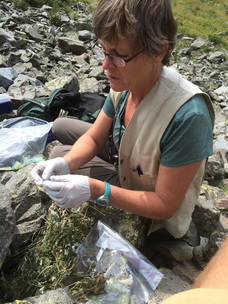
Thus far much of our summer has been spent on the slippery talus of the Bridger Mountain range in hopes of finding sign of pika. The countless data entry points taken quickly become tedious, making this week’s trip to the Crazy Mountain range a welcome relief.
For the past five years April has been making the two hour drive to the Crazies in order to monitor an active pika population. The mid-elevation alpine location which she regularly monitors has multiple pikas actively haying during the summer season. The density of the pika population area makes it a good area in which to collect genetics information. In order to collect DNA from a certain pika, April must collect fresh scat samples. Scat samples can be found in hay piles or from latrine sites. Pikas create hay piles from grasses, forbs, shrubs and trees in order to stash food that they eat throughout the coming winter. When collecting scat it is important to disturb the haypile as little as possible in order to ensure that the pika will return, while being careful not to contaminate the sample. Once a sample is taken it is sent to a lab in Reno Nevada for analysis. This week we were able to collect scat samples from four separate hay piles from one area in the Crazies.
The data collected this week will be added to the years of genetic data that April has compiled thus far. She has taken data in the Crazies as well as other ranges in Montana. In analyzing the results that are returned from the lab she hopes to discover what genetic similarities and variations pikas have from across the state.
This week will be spent continuing an extensive survey in near Emerald Lake in the Hyalite National Forest, and Max' last!
For the past five years April has been making the two hour drive to the Crazies in order to monitor an active pika population. The mid-elevation alpine location which she regularly monitors has multiple pikas actively haying during the summer season. The density of the pika population area makes it a good area in which to collect genetics information. In order to collect DNA from a certain pika, April must collect fresh scat samples. Scat samples can be found in hay piles or from latrine sites. Pikas create hay piles from grasses, forbs, shrubs and trees in order to stash food that they eat throughout the coming winter. When collecting scat it is important to disturb the haypile as little as possible in order to ensure that the pika will return, while being careful not to contaminate the sample. Once a sample is taken it is sent to a lab in Reno Nevada for analysis. This week we were able to collect scat samples from four separate hay piles from one area in the Crazies.
The data collected this week will be added to the years of genetic data that April has compiled thus far. She has taken data in the Crazies as well as other ranges in Montana. In analyzing the results that are returned from the lab she hopes to discover what genetic similarities and variations pikas have from across the state.
This week will be spent continuing an extensive survey in near Emerald Lake in the Hyalite National Forest, and Max' last!
 RSS Feed
RSS Feed
